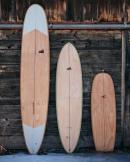Builders' Forum |
|
| ↓ Scroll to Last Comment ↓ | Forum Guidelines | Builders' Forum | |
Bedding / finishing wooden cleats
I'll be installing a number of wood cleats on my Lake Union Swift, having found a nice source for them on Etsy. They'll be screwed to the mast, boom, breasthook, and the quarter knees, which will all be varnished. Wondering two things:
- Finish: Should I epoxy coat and then varnish them as with the rest of the bright finished elements, or will the varnish not hold up well under halyards and dock lines? Is something like a tung oil finish preferred?
- And how should they be bedded? If I go with an oil or other non-varnish finish, I'm thinking I may want to remove them when the time comes to re-varnish the hull and spars, so wouldn't want something too tenacious. But if the cleats do get varnished, maybe a semi-permanent bond is ok?
The cleats are mostly made of black locust and white oak.
6 replies:
RE: Bedding / finishing wooden cleats
Thanks Peter! The butyl tape option for bedding hardware sounds great to me. Trying to weigh the pros/cons of Sikaflex vs. 3M 5200 vs. 4200 vs. Dolfinite vs. lord knows what else was getting confusing. I've now read up a little on the butyl stuff and it sounds very easy to work with and at least as effective as the others in keeping the water from creeping in.
I appreciate the tip!
Still need to decide which oil finish to use on the cleats. I'll look into Cetol and the Deks Olje. Wondering if they can also be used over epoxy on the other bright finished areas so that I don't need to use too many different products.
RE: Bedding / finishing wooden cleats
The application instructions for Deks Olje specifically say to apply it to bare wood which has been sanded to 100 grit, and Cetol may be the same. I'd use it on solid trim pieces, masts, bowsprits, floor boards etc, which are not made of ply and don't need the protection of epoxy, basically anything made of solid wood. On the epoxy coated parts, you need either paint or spar varnish for the uv protection, otherwise the epoxy will degrade and flake off.
RE: Bedding / finishing wooden cleats
Cetol is also meant for bare wood as it is meant to soak in. I used it on my spars and trim pieces. Not as nice looking as varnish, but easier to take care of. I work think you definitely want a finish that soaks in as anything else will rub right off.
RE: Bedding / finishing wooden cleats
I made up a set of white oak cleats for various boats. I put them in a glass jar of linseed oil and left it in the hot summer sun for a week. After that they got a quick wipe and another day for the oil to dry then installed. They are still going strong ten years later.
RE: Bedding / finishing wooden cleats
The linseed oil is a good and traditional suggestion. If you decide to go that route, be sure to buy "boiled" linseed oil and not "raw". The "raw" has no driers in it and will never harden.













RE: Bedding / finishing wooden cleats
» Submitted by Shapiro, Peter - Wed, 5/29/24 » 12:23 PM
There is nothing to be gained by applying epoxy or varnish to wooden cleats, as both will be rubbed off by the lines. As you suggested, an oil finish would work much better, something like Cetol or Deks Olje or something as simple as teak oil. Non of those will work indefinitely, but will be very easy to maintain by simply wiping on a fresh coat as needed. For bedding down, you want something which will be waterproof as well as easily removable. The traditional product is Dolphinite, which comes in a quart can and is applied with a putty knife. One can is usually a lifetime supply. What I use is butyl tape, which is available in different widths at many hardware, auto, and marine stores. Simply cut a piece of appropriate length, place it between the cleat and the boat/mast/rail/whatever, and screw it down securely, scraping off whatever is forced out of the joint afterwards. Easy!